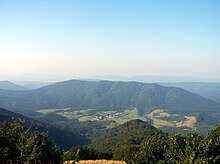Poloniny National Park
| Poloniny National Park Národný park Poloniny |
||
|---|---|---|
| Panorama of the national park | ||
|
|
||
| Location: | Prešovský , Slovakia | |
| Specialty: | Eastern Carpathian Biosphere Reserve , z. T. UNESCO World Heritage | |
| Next city: | Snina | |
| Surface: | 298.05 km² | |
| Founding: | October 1, 1997 | |
| Address: | Sprava Národného parku Poloniny ul . Mieru 193 067 61 Stakčín |
|
The Poloniny National Park ( Slovak Národný park Poloniny ) is a Slovak national park in the far east of the country. It extends in the Bukovské vrchy Mountains , which belong to the Forest Carpathians . The core zone of the park is 298.05 km². The Poloniny National Park is part of the Eastern Carpathian Biosphere Reserve , which was proclaimed in 1992 and which, in addition to this park, also includes the Polish Bieszczady National Park and the Ukrainian Ush National Park . Some parts have been part of the UNESCO World Heritage " Primeval Beech Forests in the Carpathians " since 2007 .
The administrative seat is in Stakčín .
history
The direct predecessor of the national park was the Eastern Carpathian landscape protection area , which was proclaimed in 1977 and covered a much larger area. In 1997, part of the nature reserve was converted into a national park. The name of the park comes from the local name for mountain meadows, the poloniny (Sg. Polonina ) and not, as in other Slovak national parks, the name of the mountain range (otherwise the national park would have to be Bukovské vrchy). On December 3, 2010, on the occasion of the International Year of Biodiversity, the national park was also declared a Dark-Sky Park , i. H. an area in which the night sky is protected from light pollution and astronomical popular education is to be intensified.
geography
The Poloniny National Park has a peripheral location within Slovakia on the borders with Poland and Ukraine and is part of the historical Zemplín landscape . It covers the Bukovské vrchy Mountains , a flysch mountain range within the Eastern Carpathians . Administratively it belongs to the political district Prešovský kraj ( Okres Snina ). The nearest town is Snina . The highest point of the park is located directly at the three-country point Slovakia-Poland-Ukraine just below the Kremenec mountain ( 1208 m nm ), which is also the easternmost point in Slovakia.
The core zone of the park covers 298.05 km² and forms an almost completely closed unit. The protection zone is 109.73 km² and includes the mostly sparsely populated communities within the park. The national park covers a total of 407.78 km².
The rivers and streams in the area belong to the catchment area of the Tisza , a tributary of the Danube . Significant rivers in the east of the park are the Ulička and Zbojský potok . In the western part there are the Udava and the Cirocha . The Starina reservoir , which serves as an important reservoir for eastern Slovakia, is located on this river near the Jalová municipality .
Flora and fauna
About 80% of the national park area is covered by forests, where mostly beeches grow. Oaks , hornbeams and maples grow in the lower elevations . A significant part of it is still primeval forests ; the park is considered to be the area with the greatest concentration of primeval forests in Slovakia. For this reason, some forests, such as that in Stužica near the Nová Sedlica municipality , are strictly protected. In addition to the dense forests, the poloniny , mountain meadows are characteristic of the park . Belonging to the Eastern Carpathians is also reflected in the local flora. A higher number of endemic, rare or endangered plant species are concentrated in the national park. So far, more than 1000 species of land plants as well as more than 800 mushroom, 300 moss and 100 lichen species are known. The East Carpathian endemics include the following plants: Carpathian buttercup ( Ranunculus carpaticus ), pink salsify ( Scorzonera rosea ), barnacle ( Dianthus barbatus ), Waldstein's thistle ( Cirsium waldsteinii ), Euphorbia sojakii , Viola dacica (genus Violet) and others. For some of these plants the western limit of their distribution is here. For others, such as Linum trigynum or common clematis ( Clematis vitalba ), however, the northern border is here.
The fauna is determined by the presence of deciduous and mixed forests. To date, a few thousand (depending on the source 3600 to 6000) species of invertebrates are known, including almost 1200 beetles or more than 300 species of spiders. The national park is home to around 300 species of vertebrates, of which around two thirds are birds, around 60 mammals, 13 amphibians and eight reptiles. Many large forest animals of Slovakia live here, such as brown bears , wolves and otters . More rarely you can also meet Eurasian lynx , bison or elk (the last two more from the Polish National Park).
tourism

In addition to various marked hiking trails through the national park, the presence of some wooden churches is also of great tourist importance, such as those in Topoľa , Ruský Potok or Uličské Krivé .
Special nature protection
Some areas in the national park are still specially protected. These include:
- Národné prírodné rezervácie (NPR, National Nature Reserves)
|
- Prírodné rezervácie (PR, nature reserves)
|
|
The national nature reserves Havešová, Rožok, Stužica have been part of the UNESCO World Heritage "Primeval Beech Forests in the Carpathians" since 2007.
literature
- Ján Lacika, Kliment Ondrejka: Prírodné Krásy Slovenska - Národné parky . Ed .: DAJAMA. 1st edition. Bratislava 2009, ISBN 978-80-89226-27-6 .
Web links
- Entry on the UNESCO World Heritage Center website ( English and French ).
- Short entry on the national park on sopsr.sk (Slovak)
- Full description (Slovak)




